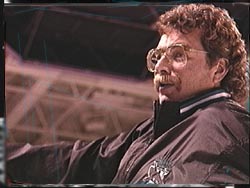|


|
Center Ice as viewed from the press box at the San Jose Arena.
|
|
One of the most unique aspects of hockey is the surface on
which the game is played: the ice itself. The players talk about the quality
of the ice; they've helped coin the terms "fast ice" and "slow
ice." Scientists, on the other hand, are still studying the chemistry
of the ice. In just the last few years, there have been major discoveries
which have changed our understanding about the nature of the ice.
In this section, there are RealAudio and video
clips from Sharks defenseman Doug Bodger, chemist Gabor Somorjai of the
Lawrence Berkeley National Laboratory, and San Jose Arena ice maker Bruce
Tharaldson.
|
|
Fast Ice and Slow Ice
Anyone who has watched a hockey game on television has heard
the announcers use the the terms "fast ice" and "slow ice,"
or even "good ice" and "bad ice." What's the difference?
Fast ice is harder and colder with a smoother surface, while slow ice is
warm and soft and may have a rough surface. For the players, the difference
seems to be that "fast ice" is less "chippy" and there
is less "snow." Passing and skating are easier when the ice is
"fast." The quality of the ice differs during the course of the
game and it even changes how teams play the game. Sharks defensemen Doug
Bodger told us, "At the end of periods when the ice tends to get 'snowier',
and the puck tends to bounce a little bit, you might not try to 'stick-handle'
as much-you might just try to get the puck out the zone." In other
words, players tend to make a safe play rather than a finesse play when
"slow ice" or "bad ice" conditions exist.
|

|
The San Jose Sharks' Doug Bodger discusses fast ice
and slow ice.
|
|
|
Oh, Canada
Certain arenas seem to have better ice than others. Bodger
thinks the difference is the hardness of the ice. Rinks in Canada are well
known for the quality of their ice. Edmonton in particular was mentioned
by Bodger as having fast ice. Why is the ice so much better in Canada? One
of the differences may be climate. Bruce Tharaldson, the ice maker at the
San Jose Arena, cited deliveries to the arena as a concern. Opening the
delivery doors of the arena and letting in heat and humidity is a problem
in San Jose, California. This is not as much of a concern for a rink in
Edmonton, Alberta, especially in the middle of winter. Apparently, the freezing
and refreezing of the ice brings impurities to the surface.
|
|

|
Ice maker Bruce Tharaldson discusses how the temperature
of the ice is changed when preparing for hockey as opposed to figure skating.
|
|
Keeping the ice cold is one of the keys to maintaining fast
ice. Bruce Tharaldson keeps the temperature of the ice at sixteen degrees
Fahrenheit (-9 centigrade) for hockey and twenty-two degrees (-5.5 centigrade)
for figure skating. Apparently, the figure skaters prefer softer ice for
their landings and the six-degree temperature difference provides that.
|
Click the "forward"
button below to continue.
|
|

©
Exploratorium
|